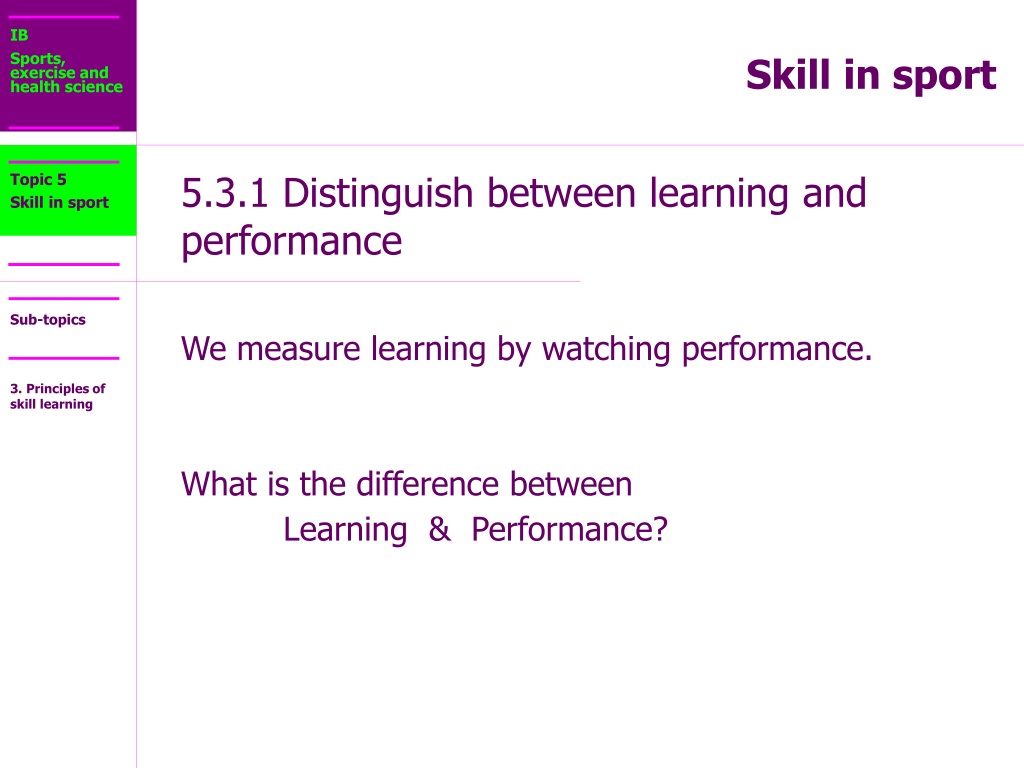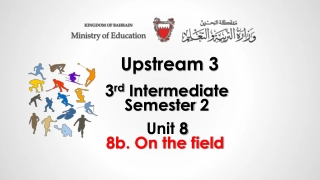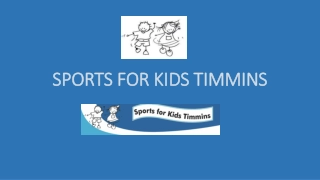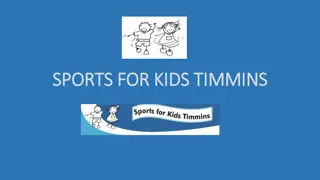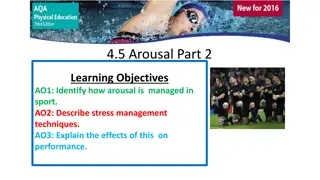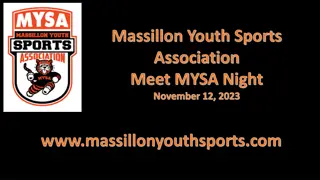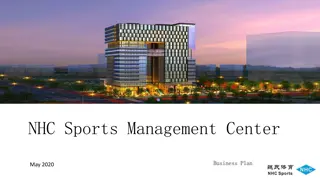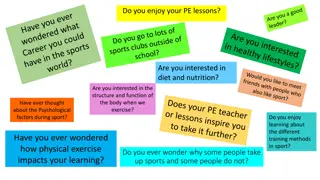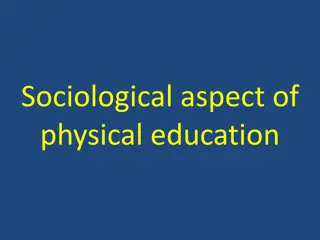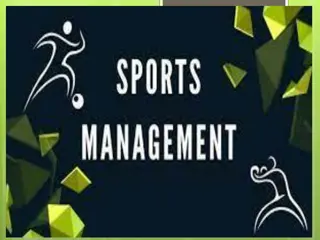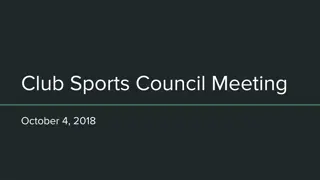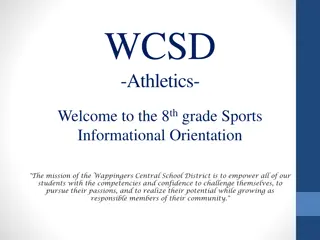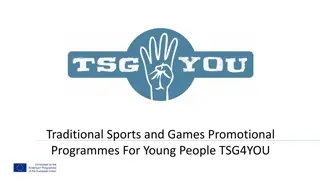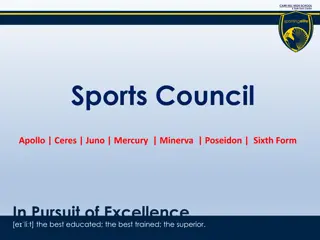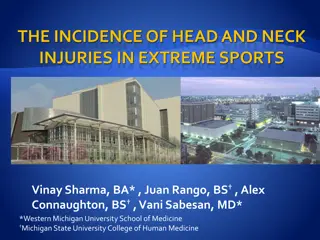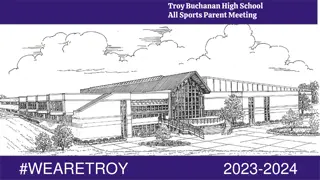Understanding the Difference Between Learning and Performance in Sports Science
Learning in sports refers to a relatively permanent change in performance through experience, excluding maturation and degeneration, while performance is a temporary occurrence that fluctuates over time. Coaches must consider these differences when designing training sessions for improving both performance and learning. The stages of learning, such as the cognitive/verbal and associative/motor stages, highlight key aspects of skill acquisition in sports.
Download Presentation

Please find below an Image/Link to download the presentation.
The content on the website is provided AS IS for your information and personal use only. It may not be sold, licensed, or shared on other websites without obtaining consent from the author. Download presentation by click this link. If you encounter any issues during the download, it is possible that the publisher has removed the file from their server.
E N D
Presentation Transcript
IB Sports, exercise and health science Skill in sport Topic 5 Skill in sport 5.3.1 Distinguish between learning and performance Topic 5 Skill in sport Sub-topics We measure learning by watching performance. 3. Principles of skill learning 3. Principles of skill learning What is the difference between Learning & Performance?
IB Sports, exercise and health science Skill in sport Topic 5 Skill in sport 5.3.1 Distinguish between learning and performance Topic 5 Skill in sport Learning is a relatively permanent change in performance brought about by experience, excluding changes due to maturation and degeneration. Sub-topics 3. Principles of skill learning 3. Principles of skill learning Performance is a temporary occurrence, fluctuating over time. A change in performance over time is often used to infer learning. IBO February 2007
IB Sports, exercise and health science Skill in sport Topic 5 Skill in sport 5.3.1 Distinguish between learning and performance Topic 5 Skill in sport Sub-topics Research/Thinking Task: Consider the differences/implications for a coach when designing a training session for performance Vs learning. 3. Principles of skill learning 3. Principles of skill learning
IB Sports, exercise and health science Skill in sport Topic 5 Skill in sport 5.3.1 Distinguish between learning and performance Topic 5 Skill in sport Is a skilled performer accurate and/or precise? Sub-topics 3. Principles of skill learning 3. Principles of skill learning What about a novice?
IB Sports, exercise and health science Skill in sport Topic 5 Skill in sport 5.3.2 Describe the phases (stages of learning) Topic 5 Skill in sport 1) Cognitive/Verbal Stage Sub-topics 3. Principles of skill learning 3. Principles of skill learning Is the earliest phase of learning. There is quite a lot of trial and error in this stage, the beginner trying out certain movements which may be successful or fail. Honeybourne et.al 2004
IB Sports, exercise and health science Skill in sport Topic 5 Skill in sport 5.3.2 Describe the phases (stages of learning) Topic 5 Skill in sport 2) The associative/motor/practice stage Sub-topics In this stage the performer practices, and compares or associates the movements produced with the mental image. This is the stage at which feedback occurs and the learner gradually becomes more aware of the increasingly subtle and complex cues. During this stage a vast improvement in performance usually occurs. 3. Principles of skill learning 3. Principles of skill learning Honeybourne et.al 2004
IB Sports, exercise and health science Skill in sport Topic 5 Skill in sport 5.3.2 Describe the phases (stages of learning) Topic 5 Skill in sport Sub-topics 3) The autonomous stage/final phase 3. Principles of skill learning 3. Principles of skill learning Is the final stage of the skill-learning process. Movements are becoming almost automatic, with very little conscious thought. Any distractions are largely ignored and the performer is able to concentrate on more peripheral strategies and tactics. Honeybourne et.al 2004
IB Sports, exercise and health science Skill in sport Topic 5 Skill in sport 5.3.2 Describe the phases (stages of learning) Topic 5 Skill in sport Sub-topics It is said that during the final stage motor programmesare completely formed in the long term memory and reaction time is short. 3. Principles of skill learning 3. Principles of skill learning For performers to stay in this phase they must continuously refer back to the associative stage, where practice ensures that motor programmes are reinforced. Honeybourne et.al 2004
IB Sports, exercise and health science Skill in sport Topic 5 Skill in sport 5.3.3 Outline the different types of learning curve Topic 5 Skill in sport A learning curve is a way to evaluate the extent to which a skill is being learnt by plotting measures of practice versus measures of performance. Sub-topics 3. Principles of skill learning 3. Principles of skill learning
IB Sports, exercise and health science Skill in sport Topic 5 Skill in sport 5.3.3 Outline the different types of learning curve Topic 5 Skill in sport Linear As practice increases, so does performance in a proportional relationship. Units Of Performance Features and possible reasons: Practice is successful Practice is beneficial High motivation Positive coaching Simplicity of the skill Performer is interested in the skill Units of performance Linear As practice increases, so does performance in a proportional relationship. Units Of Performance Sub-topics 3. Principles of skill learning 3. Principles of skill learning Features and possible reasons: Practice is successful Practice is beneficial High motivation Positive coaching Simplicity of the skill Units of practice Performer is interested in the skill
IB Sports, exercise and health science Skill in sport Core 2: Factors Topic 5: Skill in sport 5.3.3 Outline the different types of learning curve Core 2: Factors Skill in sport Topic 5: Positively accelerated curve Indicates slight performance gains initially then rapid improvements in performance (ie. the task took a long time to learn). Sub topics 3. Principles of skill learning 3. Principles of skill learning Features and possible reasons: Increasing task complexity Information overload in early stages Learner gradually developing an interest Units of performance Units of practice
IB Sports, exercise and health science Skill in sport Topic 5 Skill in sport 5.3.3 Outline the different types of learning curve Topic 5 Skill in sport After steady improvements in performance, a learning plateau is a stage where there appears to be little or no improvement. This can be due to: Lack of motivation Fatigue (over-training) Fundamentals learnt, next skill difficult Limited time devoted to practice Injury Coach unable to connect with athlete Reference 1: Board of Studies NSW (1999). Personal development, health and physical education: Stage 6 syllabus. Reference 2: Browne, S. (2001). HSC core 2 health priorities in Aust.: Summary quest. sample HSC extended responses. Reference 3: Browne, S., et. al. (2000). PDHPE application and inquiry: HSC course. Oxford University Press: Melbourne. Reference 4: Buchanan, D. Nemec, M. (2003). HSC PDHPE. McMillan Education Australia: Melbourne. Reference 5: Charles Sturt University. NSW HSC online. Available: http://hsc.csu.edu.au/pdhpe/ After steady improvements in performance, a learning plateau is a stage where there appears to be little or no improvement. This can be due to: Lack of motivation Fatigue (over-training) Fundamentals learnt, next skill difficult Limited time devoted to practice Injury Coach unable to connect with athlete Reference 1: Board of Studies NSW (1999). Personal development, health and physical education: Stage 6 syllabus. Reference 2: Browne, S. (2001). HSC core 2 health priorities in Aust.: Summary quest. & sample HSC extended responses. Reference 3: Browne, S., et. al. (2000). PDHPE application and inquiry: HSC course. Oxford University Press: Melbourne. Sub-topics 3. Principles of skill learning 3. Principles of skill learning Reference 4: Buchanan, D. & Nemec, M. (2003). HSC PDHPE. McMillan Education Australia: Melbourne. Reference 5: Charles Sturt University. NSW HSC online. Available: http://hsc.csu.edu.au/pdhpe/
IB Sports, exercise and health science Skill in sport Topic 5: Skill in sport Negatively accelerated curve Topic 5: Skill in sport Indicates rapid initial improvements then lesser gains from practice (learning slowed). Sub topics 3. Principles of skill learning 3. Principles of skill learning Features and possible reasons: Practice highly successful, but then tapered off Physical fatigue Loss of interest Loss of motivation Limited ability of coach to assist Substandard equipment Units of performance Units of practice Reference 1: Board of Studies NSW (1999). Personal development, health and physical education: Stage 6 syllabus. Reference 2: Browne, S. (2001). HSC core 2 health priorities in Aust.: Summary quest. sample HSC extended responses. Reference 3: Browne, S., et. al. (2000). PDHPE application and inquiry: HSC course. Oxford University Press: Melbourne. Reference 4: Buchanan, D. Nemec, M. (2003). HSC PDHPE. McMillan Education Australia: Melbourne. Reference 5: Charles Sturt University. NSW HSC online. Available: http://hsc.csu.edu.au/pdhpe/ Reference 1: Board of Studies NSW (1999). Personal development, health and physical education: Stage 6 syllabus. Reference 2: Browne, S. (2001). HSC core 2 health priorities in Aust.: Summary quest. & sample HSC extended responses. Reference 3: Browne, S., et. al. (2000). PDHPE application and inquiry: HSC course. Oxford University Press: Melbourne. Reference 4: Buchanan, D. & Nemec, M. (2003). HSC PDHPE. McMillan Education Australia: Melbourne. Reference 5: Charles Sturt University. NSW HSC online. Available: http://hsc.csu.edu.au/pdhpe/ Slide reference: Ruskin, R., Proctor, K. & Neeves, D. (2001). Outcomes 2: Personal Development, Health & Physical Education HSC Course John Wiley & Sons, Milton.
IB Sports, exercise and health science Skill in sport Core 2: Skill in sport Topic 5: Core 2: Topic 5: Learning plateau Skill in sport This indicates little learning is taking place for a short time and then skill attainment continues. Sub topics Features and possible reasons: Lack of practice Declining interest Lack of drive or motivation Inability of coach to provide skills and knowledge Injury A poor grasp of the fundamentals 3. Principles of skill learning 3. Principles of skill learning Units of performance Units of practice Reference 1: Board of Studies NSW (1999). Personal development, health and physical education: Stage 6 syllabus. Reference 2: Browne, S. (2001). HSC core 2 health priorities in Aust.: Summary quest. sample HSC extended responses. Reference 3: Browne, S., et. al. (2000). PDHPE application and inquiry: HSC course. Oxford University Press: Melbourne. Reference 4: Buchanan, D. Nemec, M. (2003). HSC PDHPE. McMillan Education Australia: Melbourne. Reference 5: Charles Sturt University. NSW HSC online. Available: http://hsc.csu.edu.au/pdhpe/ Reference 1: Board of Studies NSW (1999). Personal development, health and physical education: Stage 6 syllabus. Reference 2: Browne, S. (2001). HSC core 2 health priorities in Aust.: Summary quest. & sample HSC extended responses. Reference 3: Browne, S., et. al. (2000). PDHPE application and inquiry: HSC course. Oxford University Press: Melbourne. Reference 4: Buchanan, D. & Nemec, M. (2003). HSC PDHPE. McMillan Education Australia: Melbourne. Reference 5: Charles Sturt University. NSW HSC online. Available: http://hsc.csu.edu.au/pdhpe/ Slide reference: Ruskin, R., Proctor, K. & Neeves, D. (2001). Outcomes 2: Personal Development, Health & Physical Education HSC Course John Wiley & Sons, Milton.
IB Sports, exercise and health science Skill in sport Core 2: Skill in sport Topic 5: 5.3.4 Discuss factors that contribute to different rates of learning Core 2: Topic 5: Skill in sport Sub topics Research task: Answer the question above with consideration of the following. 3. Principles of skill learning 3. Principles of skill learning Physical maturation Physical fitness Motivation
IB Sports, exercise and health science Skill in sport Core 2: Skill in sport Topic 5: Core 2: Topic 5: 5.3.5 Define the concept of transfer Skill in sport Sub topics Transfer in skill acquisition - is the influence of learning and/or performance of one skill on the learning and/or performance of another. 3. Principles of skill learning 3. Principles of skill learning proactive transfer -If the transfer influences a skill yet to be learned or performed. retroactive transfer- if it influences the performance of a previous learnt skill. Honeybourne et.al 2004
IB Sports, exercise and health science Skill in sport Core 2: Skill in sport Topic 5: Core 2: Topic 5: 5.3.5 Define the concept of transfer Skill in sport Sub topics Positive transfer -One skill can help in the learning or performance of another skill. 3. Principles of skill learning 3. Principles of skill learning Negative transfer One skill may hinder the learning or performance of another skill. Honeybourne et.al 2004
IB Sports, exercise and health science Skill in sport Core 2: Skill in sport Topic 5: Core 2: Topic 5: 5.3.6 Outline the types of transfer Skill in sport Positive transfer Sub topics A player involved in team games, such as football or hockey, would be able to transfer their spatial awareness, tactical understanding of passing from one game to another. 3. Principles of skill learning 3. Principles of skill learning Wesson et.al 2005
IB Sports, exercise and health science Skill in sport Core 2: Skill in sport Topic 5: Core 2: Topic 5: 5.3.6 Outline the types of transfer Skill in sport Sub topics Negative 3. Principles of skill learning 3. Principles of skill learning The familiar example of tennis having a negative effect on badminton is often quoted, but although the two games have similar aspects, tactics, use of space, court, net, racket, hand eye coordination etc, the wrist arm movement are very different. Wesson et.al 2005
IB Sports, exercise and health science Skill in sport Core 2: Skill in sport Topic 5: Core 2: Topic 5: 5.3.6 Outline the types of transfer Skill in sport Sub topics Zero Transfer 3. Principles of skill learning 3. Principles of skill learning When one skill/task has no effect on the performance of another skill, e.g. swimming on horse riding, zero transfer is said to occur. Wesson et.al 2005
IB Sports, exercise and health science Skill in sport Core 2: Skill in sport Topic 5: Core 2: Topic 5: 5.3.6 Outline the types of positive transfer Skill in sport Sub topics Skill to Skill 3. Principles of skill learning 3. Principles of skill learning Transfer the same motion from one sport to another sport. Throwing a ball and then throwing a javalin Wesson et.al 2005
IB Sports, exercise and health science Skill in sport Core 2: Skill in sport Topic 5: Core 2: Topic 5: 5.3.6 Outline the types of transfer Skill in sport Bilateral transfer Sub topics 3. Principles of skill learning 3. Principles of skill learning Occurs when learning is transferred from limb to limb i.e. from the right leg to the left leg. When a basketball coach tries to develop their players weaker dribbling hand by relating it to earlier skills learnt they are involved in bi-lateral transfer. Involves the player in transferring both motor proficiency and levels of cognitive involvement. Wesson et.al 2005
IB Sports, exercise and health science Skill in sport Core 2: Skill in sport Topic 5: Core 2: Topic 5: 5.3.6 Outline the types of transfer Skill in sport Sub topics Practice to performance 3. Principles of skill learning 3. Principles of skill learning Repeat a complete skill over and over to perfect the outcome. Using a batting machine for hitting in baseball. Wesson et.al 2005
IB Sports, exercise and health science Skill in sport Core 2: Skill in sport Topic 5: Core 2: Topic 5: 5.3.6 Outline the types of transfer Skill in sport Sub topics Abilities to Skill 3. Principles of skill learning 3. Principles of skill learning Practice a specific movement to improve performance. Jump on one leg to improve push off blocks for sprint start
IB Sports, exercise and health science Skill in sport Core 2: Skill in sport Topic 5: Core 2: Topic 5: 5.3.6 Outline the types of transfer Skill in sport Sub topics Stage to Stage: 3. Principles of skill learning 3. Principles of skill learning When a coach develops specific practices/skills which are very realistic and relevant to the real game situation in order to try and help players in future games, this is referred to as near transfer. (also called near transfer) Three on Three to real game. Wesson et.al 2005
IB Sports, exercise and health science Skill in sport Core 2: Skill in sport Topic 5: Core 2: Topic 5: 5.3.6 Outline the types of transfer Skill in sport Sub topics Principles to skills 3. Principles of skill learning 3. Principles of skill learning Analyse a skill and determine what principles of movement apply. Very cognitive. Learning that long levers aid throwing use this to improve your throw. Wesson et.al 2005
IB Sports, exercise and health science Skill in sport Core 2: Skill in sport Topic 5: Core 2: Topic 5: 5.3.6 Outline the types of transfer Skill in sport Sub topics Activity: Give an example of positive, negative and zero as they apply to: 3. Principles of skill learning 3. Principles of skill learning Skill to skill Practice to performance Abilities to skills Bilateral Stage to stage Principles to skills
IB Sports, exercise and health science Skill in sport Core 2: Skill in sport Topic 5: Core 2: Topic 5: 5.3.7 Outline the different types of practice Skill in sport Sub topics Distributed practice: is seen as practice with relatively long breaks or rest periods between each attempt or block of attempts 3. Principles of skill learning 3. Principles of skill learning Better when the individual is: Beginner Less experienced Limited preparation (physical/mental) Less motivated Wesson et.al 2004
IB Sports, exercise and health science Skill in sport Core 2: Skill in sport Topic 5: Core 2: Topic 5: 5.3.7 Outline the different types of practice Skill in sport Sub topics Massed practice: is seen as being almost continuous practice with very little or no rest at all between attempts or blocks of trials. 3. Principles of skill learning 3. Principles of skill learning Better when the individual is: Experienced Older Fitter More motivated Wesson et.al 2004
IB Sports, exercise and health science Skill in sport Core 2: Skill in sport Topic 5: Core 2: Topic 5: 5.3.7 Outline the different types of practice Skill in sport Sub topics Fixed (drill) practice: 3. Principles of skill learning 3. Principles of skill learning a specific movement is practiced repeatedly, often referred to as a drill. This type of practice is ideal for skills that are always performed in the same way, that do not require adapting to the environment. Closed, interactive and coactive skills tend to require fixed practice to allow the motor sequence to be perfected, since they will remain the same in practice as they will in competition . http://www.brianmac.co.uk/continuum.htm
IB Sports, exercise and health science Skill in sport Core 2: Skill in sport Topic 5: Core 2: Topic 5: 5.3.7 Outline the different types of practice Skill in sport Sub topics Variable practice: 3. Principles of skill learning 3. Principles of skill learning practicing a skill in a variety of different contexts and experiencing the full range of situations in which the technique or tactic might be used in competition. The learner applies the skill to a number of different environments in practice, allowing both the development of the skill and the ability to adapt the skill to a range of possible situations. This is vital for open and interactive skills http://www.brianmac.co.uk/continuum.htm
IB Sports, exercise and health science Skill in sport Core 2: Skill in sport Topic 5: Core 2: Topic 5: 5.3.7 Outline the different types of practice Skill in sport Sub topics Variable practice: 3. Principles of skill learning 3. Principles of skill learning Skills practiced in new/different situations. Useful for open skills. Helps the development of schema. Helps performer adapt to meet the demands of the situation. Practice should be similar to real game situation. Wesson et.al 2004
IB Sports, exercise and health science Skill in sport Core 2: Skill in sport Topic 5: Core 2: Topic 5: 5.3.7 Outline the different types of practice Skill in sport Mental practice: Sub topics Is the mental or cognitive rehearsal of a skill without actual physical movement. In the early stages of learning (cognitive phase) mental rehearsal is initially seen as the learner going through a skill/task and building up a mental picture of the expected performance in their mind (cognitive process). Advanced performers can use mental practice to rehearse possible alternative strategies or complex actions /sequences, thus almost pre-programming their effector systems and possibly helping with response preparation, reactions and anticipation. 3. Principles of skill learning 3. Principles of skill learning Wesson et.al 2004
IB Sports, exercise and health science Skill in sport Core 2: Skill in sport Topic 5: Core 2: Topic 5: 5.3.7 Outline the different types of practice Skill in sport Mental practice: Sub topics Top skiers use it to rehearse turns, imagine the approach to gates and certain aspects of terrain. 3. Principles of skill learning 3. Principles of skill learning A traditionally held view has been that through mental practice a performer could slightly stimulate the neuromuscular systems involved in activities and thus stimulate the movement. Wesson et.al 2004
IB Sports, exercise and health science Skill in sport Core 2: Skill in sport Topic 5: Core 2: Topic 5: 5.3.8 Explain the different types of presentation Skill in sport Whole: Sub topics The whole method of learning is when the activity or skill is presented in total and practised as full/entire skilled movement or activity. It is argued that if a whole approach is used then a learner is able to develop their kinaesthetic awareness or total feel for the activity. This approach is seen as a more effective use of time and should be used whenever possible particularly when skills have low levels of complexity and high levels of organisation, e.g. bench press in weight training. In this case the components of the skill are unable to be broken down. 3. Principles of skill learning 3. Principles of skill learning Wesson et.al 2004
IB Sports, exercise and health science Skill in sport Core 2: Skill in sport Topic 5: Core 2: Topic 5: 5.3.8 Explain the different types of presentation Skill in sport Part: Sub topics Skills which are very complex but low in organisation lend themselves to being practised and learned more effectively by the parts method. An additional consideration is again how interrelated or independent the sub-routines are. Activities such as freestyle are not too complex but low in organisation lend themselves to being taught by the part method. The arms action, breathing pattern and leg action can be analysed and taught individually. 3. Principles of skill learning 3. Principles of skill learning Wesson et.al 2004
IB Sports, exercise and health science Skill in sport Core 2: Skill in sport Topic 5: Core 2: Topic 5: 5.3.8 Explain the different types of presentation Skill in sport Part: Sub topics Activities such as freestyle are not too complex but low in organisation lend themselves to being taught by the part method. The arms action, breathing pattern and leg action can be analysed and taught individually. However, if the beginner does not experience the whole stroke there is possibility that the kinaesthetic feel for the whole action could be lost. 3. Principles of skill learning 3. Principles of skill learning Wesson et.al 2004
IB Sports, exercise and health science Skill in sport Core 2: Skill in sport Topic 5: Core 2: Topic 5: 5.3.8 Explain the different types of presentation Skill in sport Whole-part:-whole Sub topics A variation on whole or part method is often used with performers in the Cognitive/Associative stages is whole- part-whole practice. The teacher/coach introduces the complete skill, highlighting the important elements. The performer then attempts to carry out the skill. As a result of any problems or faults observed the teacher then breaks the whole skill down into sub-routines in order to allow the learner to practice appropriate areas of difficulty. Once the teacher is satisfied that the problem areas have been mastered the parts are integrated back into the whole skill. 3. Principles of skill learning 3. Principles of skill learning Wesson et.al 2004
IB Sports, exercise and health science Skill in sport Core 2: Skill in sport Topic 5: Core 2: Topic 5: 5.3.8 Explain the different types of presentation Skill in sport Whole-part-whole: Sub topics Activity: Give an example of the use of Whole-Part- whole Method in the sport of your choice. 3. Principles of skill learning 3. Principles of skill learning
IB Sports, exercise and health science Skill in sport Core 2: Skill in sport Topic 5: Core 2: Topic 5: 5.3.8 Explain the different types of presentation Skill in sport Progressive part: Sub topics 3. Principles of skill learning The progressive part method is where earlier independent actions change their form to become something totally different. 3. Principles of skill learning A learner taught complex skills by the progressive part method benefits from the positive aspects of both part and whole methods. Wesson et.al 2004
IB Sports, exercise and health science Skill in sport Core 2: Skill in sport Topic 5: Core 2: Topic 5: 5.3.8 Explain the different types of presentation Skill in sport Progressive part: Sub topics 3. Principles of skill learning A gymnast coach trying to develop a gymnast s routine would often follow the progressive part method. 3. Principles of skill learning All the relatively complex but independent parts of the routine e.g. handstand, cartwheel, hand spring, somersault e.t.c. are learnt in and practised in isolation, but then linked together in small units in order that the gymnast can experience and learnt how to fluently sequence individual skills together. Wesson et.al 2004
IB Sports, exercise and health science Skill in sport Core 2: Skill in sport Topic 5: Core 2: Topic 5: 5.3.9 Outline the spectrum of teaching styles Skill in sport Command: Sub topics 3. Principles of skill learning This is the authoritarian style. Within this approach there is little consideration given to the individual with all learners treated very much in the same way. This style is thought to inhibit cognitive learning as thinking and questioning are not encouraged by the teacher. The teacher is in full control of decision making process and the learner is not allowed to develop responsibility for their own learning. 3. Principles of skill learning Wesson et.al 2004
IB Sports, exercise and health science Skill in sport Core 2: Skill in sport Topic 5: Core 2: Topic 5: 5.3.9 Outline the spectrum of teaching styles Skill in sport Command: Sub topics 3. Principles of skill learning This can result in the learner becoming a clone of the teacher. It has limitations for developing open skills as these require the performer to adapt and make their own decisions. It is useful when working with beginners, large groups and in dangerous and limited time situations where safety is paramount. 3. Principles of skill learning Wesson et.al 2004
IB Sports, exercise and health science Skill in sport Core 2: Skill in sport Topic 5: Core 2: Topic 5: 5.3.9 Outline the spectrum of teaching styles Skill in sport Reciprocal: Sub topics 3. Principles of skill learning Although what is taught is still determined by the teacher, it allows learners to take slightly more responsibility and become more involved in the decision making process. The sessions are structured in order that the objectives are clearly stated to the learners. This situation lends itself to greater social interaction than the command style. The teacher is still required to give regular feedback and monitor progress. 3. Principles of skill learning Wesson et.al 2004
IB Sports, exercise and health science Skill in sport Core 2: Skill in sport Topic 5: Core 2: Topic 5: 5.3.9 Outline the spectrum of teaching styles Skill in sport Reciprocal: Sub topics 3. Principles of skill learning This style of teaching is useful in developing a learner s: 3. Principles of skill learning Self image Confidence Communication skills (encourage interaction) Cognitive strategies (encourage decision making) Wesson et.al 2004
IB Sports, exercise and health science Skill in sport Core 2: Skill in sport Topic 5: Core 2: Topic 5: 5.3.9 Outline the spectrum of teaching styles Skill in sport Problem-solving approach Sub topics 3. Principles of skill learning The problem solving approach encourages students to be creative and develop their individual cognitive and performance processes. 3. Principles of skill learning According to their different sizes, shapes, abilities and capabilities learners can approach problems set by their teacher individually. Wesson et.al 2004
IB Sports, exercise and health science Skill in sport Core 2: Skill in sport Topic 5: Core 2: Topic 5: 5.3.9 Outline the spectrum of teaching styles Skill in sport Sub topics Problem-solving approach 3. Principles of skill learning 3. Principles of skill learning For example: Find a way to dribble past your opponent in a 1 on 1 situation. How could you gain the attack from this situation? Wesson et.al 2004
IB Sports, exercise and health science Skill in sport Core 2: Skill in sport Topic 5: Core 2: Topic 5: 5.3.9 Outline the spectrum of teaching styles Skill in sport Problem-solving approach Sub topics 3. Principles of skill learning This cognitive perspective approach is believed to have long term benefits as learners are encouraged to think about, understand and adapt performance according to a variety of situations. Variety of practice is important for positive transfer and the development of schemas. It also allows learners to deal with new or novel situations. 3. Principles of skill learning Wesson et.al 2004
